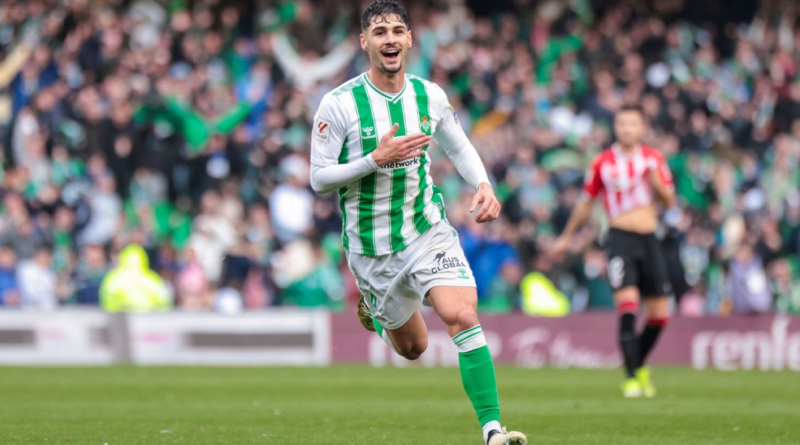After brilliant spells in Brazil and now Real Betis, can Johnny Cardoso crack into the USMNT?
One of professional soccer’s favorite adages is that a player needs a “setting-in period” when they change clubs. In a lot of ways, the thinking makes sense. Every club has its own way of doing things. There can be a new country, a different style of play and a new language in which to adjust. These changes are magnified when there is family involved.
But based on Johnny Cardoso‘s first three-and-a-half months with LaLiga side Real Betis, that maxim is being put to the test.
According to ESPN Stats & Information, among LaLiga defensive midfielders with more than 500 minutes played, the U.S. international ranks in the top six in tackle percentage (52.3%), duel percentage (62.7%) and aerial percentage (66.0%). Among that cohort, his 15.7 defensive interventions per 90 minutes of actual playing time is second in LaLiga, though he’s been sharp on the ball as well — especially in the attacking third, where his passing percentage is third in the league among defensive midfielders at 89.6%.
– Stream on ESPN+: LaLiga, Bundesliga, more (U.S.)
– Stream LIVE: Real Betis vs. Real Sociedad, Sunday, 12.50 p.m. ET, ESPN+
Current Betis sporting director Manu Farjado told ESPN that he’s been impressed with Cardoso’s “balance and tactical rigor defensively. Choosing when to press the opponent, being able to play taking just a few touches, without losing the ball.”
Cardoso’s arrival has helped Betis stay within striking distance of qualifying for European competition. With three games left to play, Los Verdiblancos currently sit in sixth place, just a point above Real Sociedad. The two teams go head-to-head on Sunday, with the winner likely getting the inside track on LaLiga’s final Europa League place for next season.
Talking to the Denville, New Jersey native, it’s clear he feels he’s exceeded even his own expectations.
“I have to confess that I didn’t expect to adapt so quickly,” Cardoso told ESPN with the help of a translator. “But the welcome and help from all the players and staff made me feel very comfortable, and made it easier for me to adapt.”
That Cardoso has performed so well at a club like Betis is even more impressive. In a league where Atletico Madrid, Barcelona, and Real Madrid take up the vast majority of the available attention — and with city rivals Sevilla taking up some as well — Betis is still considered a big club. Its season ticket base of over 50,000 usually trails only that of Barcelona and Real Madrid, and only those two plus Atletico Madrid have stadiums bigger than the 60,720-seat Estadio Benito Villamarin. (Barcelona is playing this season at the 49,472-seat Estadi Olimpic Lluis Companys while the Camp Nou undergoes renovations.)
Given that Real Betis was founded in 1907, it’s a club whose roots run deep.
“Betis fans come from generations,” said former U.S. international Tab Ramos, who spent three seasons on the books of Betis in the mid-1990s. “And it gets passed down as part of the family, as part of what they talk about in everyday life.” Ramos recalled that when he played with Betis, the club was in the second tier, but even back then when the team came out for warmups there would be “38,000 fans in the stands.” That can create an incredible atmosphere, but pressure comes with it as well. Expectations are high.
“This is how they live, and it’s not easy,” Ramos added. “You’re definitely defending a club that people care a lot about, and the result that you get every weekend has an effect on their lives. They make you feel that, and you feel that through the fans. You grow up always wanting to play in a club that’s meaningful and is big because Betis is a big club. And at the same time, it can be a little bit overwhelming to step into a club that has such pressure.”
Given that Cardoso was developed in the cauldron that is Brazilian soccer, with two-time CONMEBOL Libertadores winners Internacional, it’s an intensity and culture that isn’t alien to him. Cardoso’s ability to be clean on the ball and positionally sound in the midfield has certainly provided a foundation for quick adaptation, one he believes dovetails well with the style of LaLiga.
“Here the game is much more with the ball on your feet, much more technical,” he said in a separate interview with ESPN Brazil. “And in Brazil, there was a lot of physical stuff too. But obviously Brazil was very important to me, and I use a lot of the things I learned in Brazil here so that I can continue to evolve and enjoy it too, because it is a very special league, a league that I always dreamed of playing and well, my adaptation is being incredible.”
Cardoso’s family moved back to Brazil shortly after he was born and by age 11, he was in the youth ranks with Criciúma. He later moved to Avai and finally Internacional two years later. He was a striker up until Under-17 level, and showed even then his ability to adjust, moving to midfield. He gradually forced his way into the Reds’ lineup, catching the eye of then manager (and former Philadelphia Union midfielder) Eduardo “El Chacho” Coudet.
“My performances on the pitch only increased, and I felt very comfortable playing as a midfielder,” Cardoso said. “I’ve always been very dedicated and I adapted to this position very quickly.”
In fact, Cardoso made such an impression on Coudet — across two managerial stints with Internacional — that he felt compelled to recommend his protégé to then-Betis sporting director Ramon Planes. The two are long-time friends and even though Planes was about to leave for Saudi Arabian club Al Ittihad last December, he provided Betis with a parting gift, a player with immense composure on the ball.
2:38
Should Pulisic start as the USMNT’s No. 10 at the Copa America?
Herculez Gomez and Sebastian Salazar debate where Christian Pulisic should play for the USMNT at the Copa America.
“I’d seen him, but Coudet told me to push for him,” Planes said about Cardoso. “Chacho coached him in Brazil and his characteristics stood out from day one. He always said he was ready to play in Spain. What’s most surprising above all is his head. He’s a very intelligent boy who knows what he wants and always acts in the right way. It’s a huge plus for Betis to have a player with that characteristic.”
Indeed. Beyond his positioning and calmness on the ball, Cardoso even popped up for a goal back on Feb. 25 in a 3-1 win over Atletico Madrid, not that he’s going to let that get to his head. “Tactically, he’s almost a perfect central midfielder,” Ramos said about Cardoso. “That he was able to step into such a big club that has to win every week, and be able to do that with the calmness that he has shown is incredibly impressive for me. This kid, it seems like his pulse doesn’t go over 55.”
In a U.S. jersey, however, Cardoso has yet to show the best of himself, though the “MMA” midfield of Weston McKennie, Yunus Musah and Tyler Adams has had something to do with that. But even when one of that trio has been injured or struggling with poor form, Cardoso has found it difficult to crack the lineup, especially with Gio Reyna also pushing for time in the center of midfield. Cardoso logged just 65 minutes over two matches during last month’s Concacaf Nations League though he’s determined to push forward.
“I always say, it’s a privilege to be able to represent my country,” Cardoso said. “I don’t count on the absence of others either. I always focus a lot on my development and, as I always say, that it only depends on me, on my performance at my club, which today is Betis. And I have a very positive mind: if I develop my soccer well here, I will have opportunities in the national team.”
There is a question as to whether Cardoso can operate as a lone holding midfielder, like Adams often has. Fajardo, for one, thinks he can. But as long as Cardoso keeps up his steady performances with Betis, the opportunities at international level will eventually arrive.
“I’ve always dreamt big, so I’ve always dedicated myself to my goals,” Cardoso said. “That’s what made me get me this far and be keen to develop even further.”




